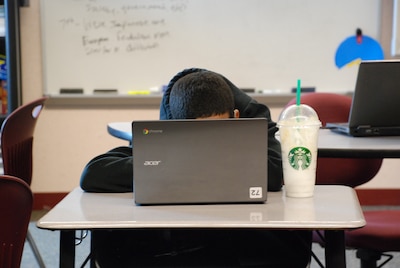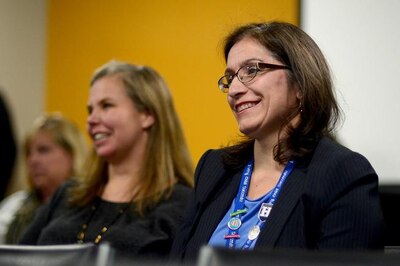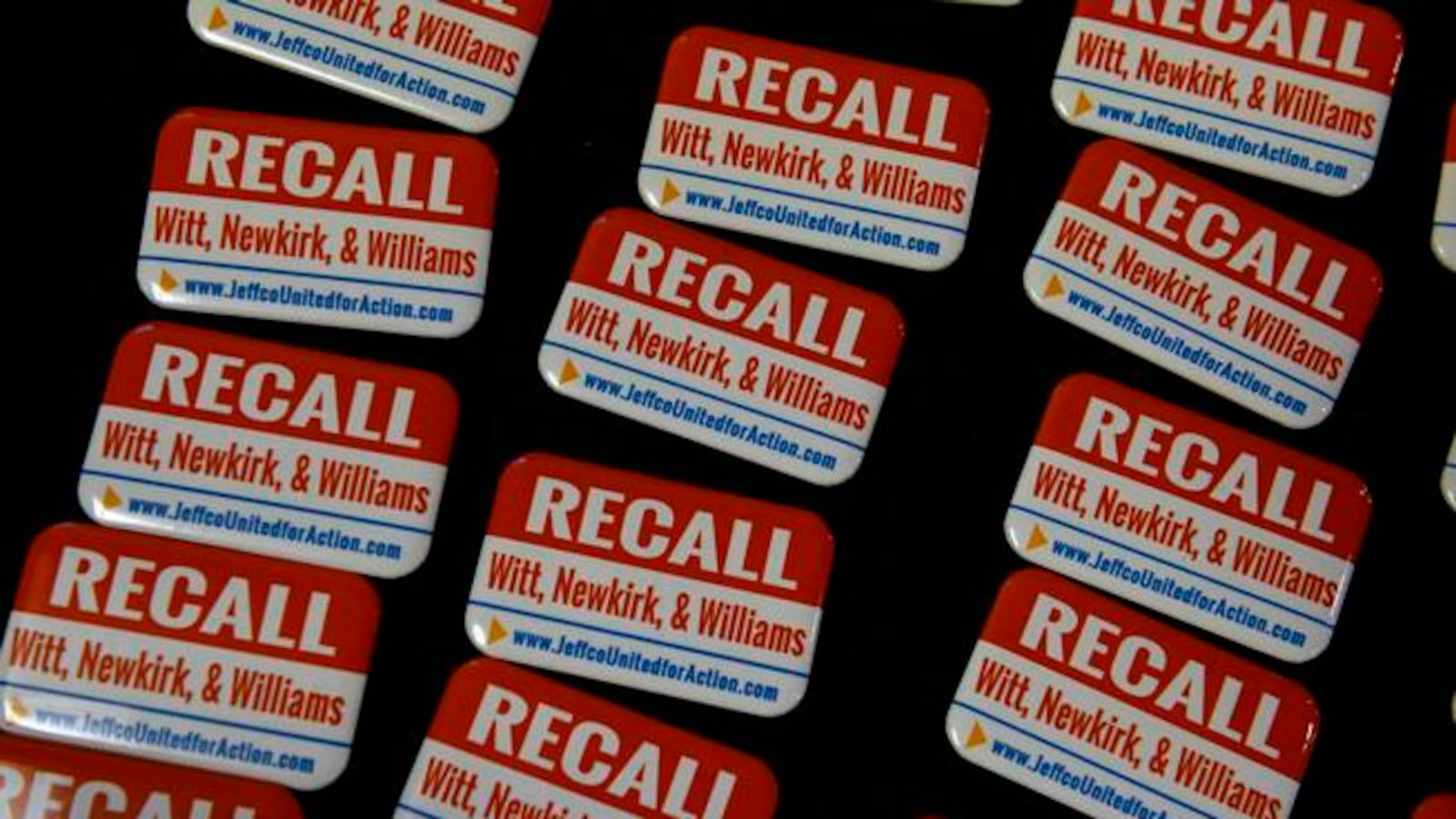Every year brings a certain amount of change. But Colorado’s education community experienced more change in 2015 than a weekend marathon of “Extreme Home Makeover.”
From the state’s ongoing testing debate to the Jefferson County school board recall, Colorado educators and observers had plenty to talk about.
Here’s a look back at the stories that had everyone in #edcolo talking in 2015 and how they might play out next year.
1. Jefferson County sent its reform school board members packing. But how the state’s largest school district will move forward remains unclear.
After two years of political acrimony in the state’s second largest school district, three conservative school board members who pushed through an ambitious reform agenda were recalled by wide margins in one of the highest off-year election turnouts in Jefferson County history.
The unusual election — which also included two open seats, putting the entire board in play — garnered national attention and echoed across the state in other races. On the same night the Jeffco board members were recalled, conservative education reformers lost up and down the Front Range, most notably in Douglas County.
The recall campaign was driven by a dogged teachers union and concerned parents who used an exhaustive ground game and social media strategy to tap into a deep well of discontent and outgun conservative groups that poured tens of thousands of undisclosed dollars into television commercials.
Many of the same issues that were recall fodder are likely to resurface in 2016, including a contract with the county’s teachers union and how to pay for full-day kindergarten.
2. Changes to the state’s testing system challenged lawmakers. Will their final compromise be enough to satisfy critics?
Reforming the state’s standardized testing system was not just one of the hot-button education issues at the Capitol this year, but one of the biggest legislative issues, period.
What will happen in 2016? | We told you what happened in 2015. Now we want you to tell us what you think will be the story to tell in 2016. Leave a comment below or send an email to co.tips@chalkbeat.org with your predictions.Years ago, state lawmakers signed off on the state updating its academic standards — which include the controversial Common Core State Standards in English language arts and math — and tests designed to test students’ mastery of them. As the state inched closer to rolling out the new PARCC exams, critics including parents, teachers and school superintendents became louder with their complaint: Too many tests.
Armed with recommendations from a task force commissioned by the 2014 legislature that outlined ways to reduce testing, lawmakers went to work crafting dozens of bills. Ultimately, an eleventh-hour compromise was reached with bipartisan support. The deal included rolling back testing in high schools, pausing the state’s system for holding schools and districts accountable for student performance, and codifying parents’ rights to refuse the test on behalf of their children.
The reduced testing goes into effect next spring while the legislature is in session. Will it be enough to curb the criticism? Or will lawmakers and critics be emboldened to further reduce testing with new freedom from the federal government?
3. The state’s first round of PARCC exams were mostly painless. However, high opt-out rates make the new “baseline” fuzzy.

Just as the testing debate reached a fever pitch, students in Colorado and 11 other states began taking the inaugural PARCC exams in English and math. The new online tests, a multi-state effort that took several years to develop, are supposed to test for higher levels of learning and critical thinking.
Although some districts reported glitches, widespread technological breakdowns did not materialize. But the controversy surrounding the tests did lead tens of thousands of students to refuse to take the test in protest, making Colorado one of the national epicenters of the opt-out movement.
When results were finally made available eight months after the first tests were given, they were not surprising: few Colorado students met the state’s expectations in both subject areas. Supporters of the tests and Colorado Department of Education officials stressed that the new standards were higher and that the results should be used as a new baseline for measuring future growth.
4. Despite some efforts and national attention, Denver schools struggled to integrate.
Twenty years after Denver Public Schools ended its court-ordered busing integration program, schools are more segregated than ever before.
In recent years, DPS officials have sought to encourage integration — which many believe boosts student learning — through the school choice process and broadening traditional school boundaries to include larger regions of the city.
But those efforts have yet to make a big difference, and officials face a major challenge in a city where housing patterns, not policy, drive the segregation of schools.
Similar debates about segregation have played out across the country. In Denver, a booming economy is attracting young, white and middle-class and upper-class families who are settling in traditional ethnic enclaves such as Denver’s Highland and Whittier neighborhoods. Districtwide, the number of students who qualify for subsidized lunches has shrunk for three years in a row.
As Denver attempts to close stubborn achievement gaps, the integration question will loom over high-profile decisions about closing some schools and opening new ones.
5. Aurora Public Schools tried to control its own destiny and boost student achievement while the state and education reformers watch skeptically.
While Denver has grabbed much of the local education spotlight — and philanthropic dollars — Aurora Public Schools to the east has struggled to meet the needs of its equally diverse and at-risk student body.

More of the education community is beginning to take notice as APS — the largest district in the state at risk of losing its accreditation because of poor academic performance — begins to make systemic changes.
The school district is in the early stages of giving some of its lowest performing schools more freedom to determine their own calendars, budgets and curricula. It’s an attempt at using existing state law to avoid state sanctions.
But Aurora isn’t moving fast enough, according to some. The Denver-based education reform group A+ Denver and Aurora-based parent advocacy organization RISE Colorado published a hard-hitting report that took APS to task for not graduating enough students and not engaging parents enough.
In December, the state’s top school improvement executive sent a letter to Aurora officials urging bold action at Aurora Central High School, if the district hopes to proceed with its plan.
As we enter the new year, Aurora teachers, parents and students will get a better understanding of what changes are in store as the district prepares to give some of its schools more freedom.
6. There’s a teacher shortage in America. But in Colorado, the situation isn’t that dire — yet.

School districts across the country and in Colorado are struggling to find and keep teachers. Newspapers across the country have reported about the teacher shortage. Meanwhile, in Colorado, more teachers either took different position or left the profession last year than ever before. And teacher prep programs aren’t filling the supply need.
School districts are taking interesting approaches: Aurora has tried to pay teachers at one school more; Denver has launched its own residency program; and the rural Bethune school district has resorted to recruiting teacher candidates from overseas.
Even the state’s largest teachers union has offered seminars on how to reduce stress, with the hope that could help reduce turnover.
Some experts have pointed to a mountain of demands facing teachers, including more paperwork, test-giving and student discipline issues. Others cite to failed leadership at the local level. Regardless, as the state’s population continues to grow — some 7.8 million people are expected to call Colorado home by 2040 — so will the demand for teachers.
7. The State Board of Education got a makeover. Then the once sleepy board made a news. A lot of news.
A reconfigured State Board of Education made plenty of headlines in 2015. Whether the board was trying to blow up the state’s testing system or punting on big decisions such as establishing new high school graduation requirements, the board kept the education community on its toes throughout the year.
The board, which has little authority as a regulatory body, often did not vote along party lines, emblematic of the complicated politics of education. For the greater part of the year, union-backed Democrat Val Flores of Denver sided with the board’s more conservative members. Meanwhile, Republican Marcia Neal, then the board chair, sided with the other Democrats.
Neal resigned in June, citing board dysfunction and her health issues. Her resignation followed other high-profile exits at the state Department of Education, including the state’s education commissioner and his top two lieutenants.
Republican Steve Durham took over as board chairman in August, and the board has not been as turbulent since.
The board recently unanimously named moderate Republican Richard Crandall, a former Arizona lawmaker, as the lone finalist to become the state’s next education commissioner.
8. Tom Boasberg stunned the education community when he announced his six month sabbatical.
The organizational chart at 1860 Lincoln is changing — at least for the time being.

Shortly after an election that saw the school board move from 6-1 to 7-0 in favor of Superintendent Tom Boasberg’s agenda, Boasberg stunned many by announcing plans to take a six-month unpaid leave to travel and study with his family in South America.
Boasberg’s tenure is unusually long for a big-city superintendent, and his sabbatical is just as unusual. On the one hand, it’s an opportunity for Boasberg’s team to shine. But it’s a risk nonetheless, as DPS faces big decisions about closing and opening schools, and starts preparing to ask voters in November to approve tax increases for its schools.
Stepping in for Boasberg is Susana Cordova, a Denver native and product of DPS who has a compelling story to tell about how education opened doors for her. Cordova, chief of schools for DPS, will serve as acting superintendent starting in January.
Shortly after Cordova’s contract was approved, another top Boasberg lieutenant announced plans to depart the district. Alyssa Whitehead-Bust, the district’s chief academic and innovation officer, said her confidence in DPS’s path inspired her to “go make a difference in a new system.”
The next few months bear watching for a number of reasons. How will Cordova lead any differently than Boasberg, and will other departures follow Whitehead-Bust’s?
9. The state’s early learning community got new rules and opportunities.
Colorado’s early childhood community grew up in 2015.
The state last winter launched “Colorado Shines,” a mandatory five-level rating system for all licensed child care providers. The system replaces an earlier voluntary system that was used by a fraction of the state’s providers.
A new nonprofit, Early Milestones Colorado, launched with the goal of improving the state’s early childhood systems. The Denver-based organization, backed by several influential foundations, is meant to identify and boost innovation across the state.
Gov. John Hickenlooper also signed a bill allowing public-private financing for early childhood projects.
Then in September, Hickenlooper and state lawmakers celebrated a new early childhood framework that is simpler and more streamlined than one first released in 2008.
But Colorado’s early childhood education community still faces plenty of challenges. In addition to curbing preschool expulsions — a hot topic in 2015 — advocates continue to work on increasing child care quality and capacity across the state.
— Chalkbeat bureau chief Eric Gorski and reporter Ann Schimke contributed.


